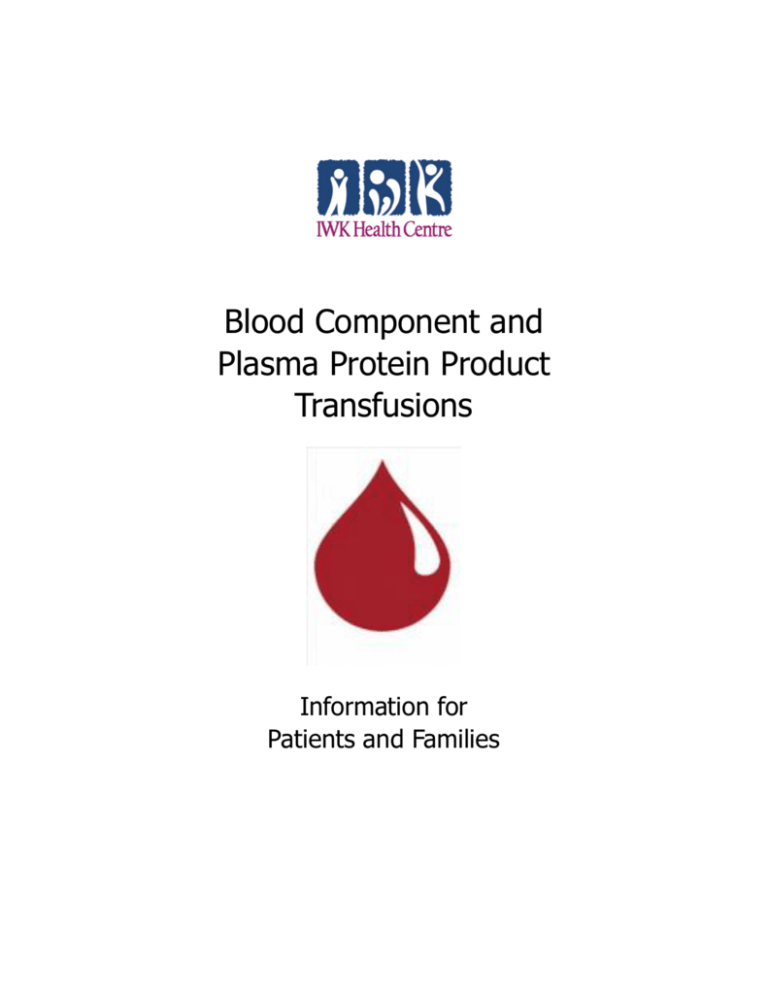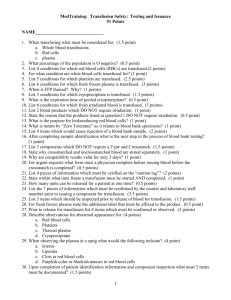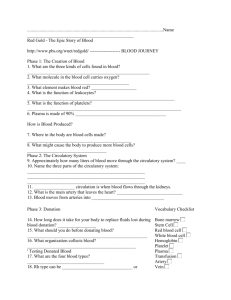
Blood Component and
Plasma Protein Product
Transfusions
Information for
Patients and Families
During your care at the IWK Health Centre, you or your child may
require a blood component or plasma protein product.
Your physician will talk to you about whether you or your child will
need a transfusion. If you or your child needs a transfusion, your
physician will talk to you about the benefits and potential risks of
transfusion for yourself or your child.
Where does the blood used at the IWK Health Centre come
from?
IWK Health Centre uses blood components or plasma protein
products received from the Canadian Blood Services.
The Canadian Blood Services collects blood from volunteers who
donate their blood for free. All of these volunteer donors answer a
long questionnaire and interview. They have some testing done to
make sure they are healthy before they are allowed to donate.
Some coagulation or other concentrate blood products (such as
Immune globulins) may contain blood donated by volunteers from
the United States.
What kind of a blood transfusion could I or my child be given?
There are several kinds of blood components and plasma protein
products.
Whole blood, as it is donated through the Canadian Blood
Services, is processed and divided into several blood components
such as red cells, platelets and plasma.
In this way, each donation can help several people. Nowadays,
whole blood is not routinely given for individual patient transfusion.
1.
Red cells or “packed red cells” contain mainly red blood cells.
The plasma or liquid part of blood is removed, along with most of the
white blood cells and platelets. Red cells are hemoglobin containing
cells.
Platelets are obtained from whole blood by a special spinning
process. Platelets are small blood cells that help to stop bleeding.
Plasma (the liquid part of blood) is also obtained from whole
blood by a special spinning process. Plasma contains many of
the blood clotting factors and other proteins.
White blood cell concentrate can be made from whole blood
by yet another spinning process. White blood cell concentrate
contains granulocytes, monocytes and lymphocytes-blood cells
which fight infection.
All of the above blood products are made from the blood of a
single donor. Other blood products are made from the plasma of
many donors pooled together. These plasma protein products
include albumin and clotting factor concentrates.
Albumin is a blood protein which helps to regulate the amount
of fluid in our circulating blood. Albumin concentrates are made
from the blood plasma of many donors who have been very
carefully tested for blood transmissible infections, as are all donors
of blood or plasma. The albumin concentrate produced is treated
to remove potential infectious agents.
Clotting factor concentrates come in several different kinds.
Each kind is made to correct a deficiency in one of the blood
clotting factors. The most common of these clotting factor
concentrates are those used to treat hemophiliacs with factor VIII
or factor IX deficiency. Most factor concentrates are
“recombinant” products and not made from donor plasma.
Immune globulin concentrate is a solution containing agents
called antibodies which fight infection or inflammation. It is
manufactured from pooled plasma donated by a group of several
hundred to several thousand donors for each “lot”. Like albumin or
clotting factor concentrates, donors are carefully screened and the
concentrate is treated to remove / destroy infectious agents.
2.
What are the benefits of blood transfusions?
Red blood cells are transfused when a person’s hemoglobin is too
low. When the hemoglobin level is too low, there is not enough
oxygen going to body tissues. With the red cell transfusion, there is
more hemoglobin to deliver oxygen to all parts of the body. Signs
and symptoms of low hemoglobin may include tiredness, shortness
of breath, paleness and a rapid heart rate.
Red cells are transfused when there is very rapid loss of blood (for
example, a severe injury or during surgery). When red blood cells
are transfused in these cases, the red cells help to deliver oxygen.
The red cells that we produce in our own body have a life span
of 120 days. Those received through blood transfusion last an
average of 45 days.
Plasma is transfused to replace some of the body proteins that
may be abnormally produced or destroyed or not working
properly. Transfused proteins last from several hours to months,
depending on the protein.
Platelets are given to patients who cannot produce enough of their
own platelets or whose platelets do not work properly. Platelets are
given only when the platelet count is very low or when the patient is
actively bleeding. The platelets that our bodies produce last about 10
to 12 days. Transfused platelets last about 5 to 7 days.
Albumin is transfused when a patient needs more fluid volume
within their blood vessels. If a patient needs to lose extra fluid, an
albumin transfusion will help to pull fluid out of the tissues into the
blood stream so that it can be passed in the urine. Normally,
albumin lasts about 21 days, but it may stay in the blood vessels
for only a short period of time.
3.
Clotting factor concentrates are given to individuals with
clotting factor deficiencies to decrease their bleeding risk.
Immune globulins (which includes zoster immune globulin, CMV
immune globulin, for example), are given to individuals who are
deficient in immune globulins and to individuals with immune
disease such as immune thrombocytopenia or Kawasaki disease.
RhD immune globulin (WinRho) is given to Rh negative women
during and after pregnancy (or to Rh negative individuals
following platelet transfusions) to prevent anti-RhD antibody
formation which can lead to hemolytic disease of the fetus and
newborn.
What are the possible risks of blood
transfusions?
Any blood component or plasma protein product can have the
following risks. If a patient has one of these transfusion reactions,
they can still be safely given blood transfusions in the future. Some
will need special precautions for future transfusions.
Severe allergic reactions can happen when the patient reacts to
something in the donor’s blood. Severe reactions can cause a very
low blood pressure and problems with breathing. Almost all allergic
reactions can be successfully treated. Less severe reactions - hives
or blotchy skin reactions - occur more often and are easily treated.
A severe allergic reaction occurs once in about every 40,000
transfusions.
Fever associated is common and easily treated. It occurs one in 300
units of red cells and one in every 20 units of platelets.
Infections. Even with careful screening of all blood donors, the risk
of transfusion related infection remains. Sometimes the tests are not
positive because the donor has just been infected and has not yet
made antibodies to the infection. Newer methods of testing have
shortened this risk period. Infections can be viral or bacterial in
nature.
In Canada, WinRho and albumin have not been associated with
transfusion acquired viral infections.
4.
Risk of infections
Examples:
HIV (the AIDS virus) 1 in 7,800,000
Hepatitis C
1 in 2,300,000
Hepatitis B
1 in 153,000
Bacterial (platelets) 1 in 10,000
Bacterial (red cells) 1 in 250,000
West Nile
less than 1 in 1,000,000
CJD
less than 1 in 10,000,000
(Creutzfeld-Jacob Disease)
These risks can be compared with other risks we have.
Canadians are at risk every year of dying from:
motor accident
drowning
air plane crash
1 in 10,000
approximately 1 in 92,000
approximately 1 in 480,000
Acute hemolytic transfusion reactions happen when the blood of
the person receiving a transfusion reacts with the transfused
blood. In this reaction, the A, B, O or Rh type of blood donor and
the patient are not “compatible.” This means that the patient
receiving the blood has antibodies (plasma proteins) which
destroy the donor’s red cells. This reaction happens during the
transfusion or immediately after.
A hemolytic reaction means that the transfused red blood cells are
broken down very quickly (hemolysis). The red cells can break down
in the liver or inside the spleen. If the red cells break down in the
liver or spleen, the usual symptoms are yellow color of the skin
(jaundice), low hemoglobin, dark colored urine and fever or muscle
pains. If the red cells break down inside the blood vessels, this
reaction can lead to shock and serious kidney damage.
Most of these reactions can be successfully treated. About one
hemolytic transfusion reaction occurs for every 40,000 red cell
transfusions given.
5.
Delayed hemolytic transfusion reactions are a type of hemolytic
reaction which can occur several days to weeks after the transfusion
is given. In a delayed transfusion reaction, the person receiving
the transfusion has antibodies which react with minor (less powerful)
blood groups on the donor’s red cells. With a delayed transfusion
reaction, the hemoglobin level falls more quickly than expected after
the transfusion and there may be mild jaundice. One of these
reactions occurs in every 7,000 transfusions. These reactions do not
usually need to be treated.
What happens if you or your child needs
a blood transfusion?
Blood transfusions are only given when there is a need for them.
If you or your child does not receive a needed transfusion,
this may have serious effects on your or your child’s health.
You should have a talk with your physician about potential
alternatives to transfusion, such as: infusion of extra fluids; or
blood salvage (where a patient’s blood is collected during surgery
so that it can be given back to the patient by transfusion later during
the surgery - if needed). In some cases, erythropoietin (a hormone
which increases the production of red blood cells) may decrease the
number of necessary transfusions.
At the moment, there is no artificial blood (blood made in the
laboratory) that does all the things that real blood can do. Substitutes
for red blood cells are very experimental. They are not available for
general use in Canada at this time.
There are still many situations where the need for a transfusion
greatly outweighs the potential risks of transfusion.
Fore more information, ask your doctor, or your child’s
doctor, or health professional.
For more information about the blood supply in Canada, or about
directed or autologous donations, please call CBS Atlantic at
1-877-758-5300 or email atlantic.medical@blood.ca. Information is
also available on the website at www.blood.ca .
6.
Notes:
7.
Prepared by the IWK Health Centre
Halifax, Nova Scotia.
Adapted from:
“Information for parents – What you need to know about
Blood Transfusions.” developed by the Toronto Hospital for Sick
Children.
Bloody easy 3: Blood Transfusions, Blood Alternatives and Transfusion Reactions: A Guide to Transfusion Medicine / J.L Callum et al.,
3rd Ed
Design, production and printing by the IWK Print Shop.
© Copyright 2004, IWK Health Centre, Halifax, Nova Scotia.
All rights reserved. Printed on recycled paper.
For copies or permission to reproduce, contact::
Transfusion Medicine Service
IWK Health Centre
5850/5980 University Avenue
PO Box 9700
Halifax, Nova Scotia
B3K 6R8
Phone: (902) 470-8858 or (902) 470-6531.
PL-0154 Last Update: 01/15
Next Review: Jan 2018










